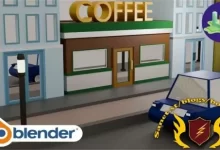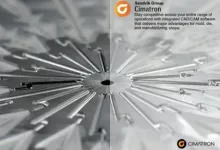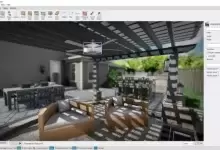视频教程:Houdini.School – HS-223 – 艺术家数学(Divyansh Mishra)
这个录制课程为艺术家提供了一种学习和发展利用数学工具的直觉,使用行业标准的程序和方法。本课程不仅展示了在Houdini中利用数学的方法,还着重于培养使用数学解决新问题的思维方式。学生还将学习一些与数学相关的技巧,以优化他们的预渲染或实时项目。
学生将通过这门课程获得对数学工具在动态图形、着色器构建和游戏编程中的不同利用方式的基本理解。学生将学会使用数学优化他们现有设置的一些方法。
第一节
理解函数与数制
在这个环节中,我们将为数字系统和数学函数打下坚实的基础。通过实际工作示例,我们将深入讨论复数、笛卡尔坐标和极坐标、在不同维度中映射数学函数以及插值的主题,以及它们在动态图形和着色器构建中的用例。
- 介绍
- 数制
- 复数简介
- 数学函数简介
- 函数代数
- 函数组合
- 一些常见函数的用例
- 笛卡尔坐标
- 使用极坐标进行空间变换的思维方式
- 线性插值和平滑步进
- 团体练习环节
第二节
理解向量
在这个环节中,我们将学习关于向量的知识。向量是计算机图形中最重要的概念之一。它们是大多数二维和三维动态图形艺术品的构建基块。我们将讨论不同的方法,以便利用向量进行问题解决和艺术方向。我们还将简要介绍多变量微积分的主题,以深入了解向量场。
- 向量简介
- 点与方向
- 向量的大小和方向
- 向量的分解
- 向量的代数
- 点积
- 叉积
- 向量场
- 散度和旋度
- 梯度向量
- 团体练习环节
第三节
理解四元数
在这个环节中,我们将使用四元数并讨论它们在欧拉旋转上的重要性。通过这个环节,我们将建立四元数与复数之间的关系,这对于调试基于四元数的算法非常有帮助。我们将学习如何使用它们来在三维空间中旋转对象,并帮助我们克服矩阵的一些限制。
- 四元数简介
- 欧拉角与四元数
- 四元数与复数的关系
- 使用四元数进行三维旋转
- 欧拉角到四元数
- 四元数到欧拉角
- 四元数到旋转矩阵
- 四元数插值
- 其他有用的四元数函数
- 团体练习环节
第四节
理解矩阵变换
在这个环节中,我们将利用我们到目前为止所学的知识来理解矩阵的概念。我们将讨论矩阵的需求和用例。我们还将深入探讨将变换打包到矩阵中,然后解包以供各种用例使用的过程。总体上,我们将通过数学和概念上的理解来尝试使用矩阵,以便更加舒适地使用它们。
Houdini.School – HS-223 – Maths for Artists with Divyansh Mishra

Duration 9h 30m Project Files Included MP4
Title: Houdini.School – HS-223 – Maths for Artists with Divyansh Mishra
Info:
This recorded course provides a way for artists to learn and develop an intuition for utilizing mathematical tools in their work using industry-standard programs and methods. This course will not only showcase ways of utilizing math in Houdini but also focus on developing a mindset to solve new problems using math. Students will also learn some math-related tips and tricks to optimize their pre-rendered or real-time projects.
Students will leave this class with a fundamental understanding of different ways in which tools from Mathematics can be utilized for Motion Graphics, Shader Building, and Gameplay Programming. Students will learn to optimize some of their existing setups using Mathematics.
Session 1
Understanding Functions & Number System
In this session, we will develop a solid foundation for the number system and mathematical functions. With the help of real work examples, we will wrap our heads around topics like complex numbers, cartesian & polar coordinates, mapping of mathematical functions in different dimensions, and interpolation with their use cases in Motion Graphics and Shader Building.
Introduction
Number System
Brief Introduction to Complex Numbers
Introduction to Mathematical Functions
Algebra of Functions
Function composition
Use cases of some common functions
Cartesian Coordinates
Developing mindset for the transformation of space using Polar Coordinates
Linear Interpolation & Smooth Step
Group Practice Session
Session 2
Understanding Vectors
In this session, we will learn about vectors. Vectors are one of the most important concepts in computer graphics. They are the building blocks for most of the 2D and 3D motion graphics art pieces. We will discuss different ways in which we can utilize vectors for problem-solving and art direction. We will also briefly look into topics from multivariable calculus to gain insights into vector fields.
Introduction to Vectors
Point Vs Direction
Magnitude & Direction of Vectors
Resolution of Vector
Algebra of Vectors
Dot Product
Cross Product
Vector Fields
Divergence & Curl
Gradient Vectors
Group Practice Session
Session 3
Understanding Quaternions
In this session, we will work with Quaternions and discuss their significance over Euler rotations. Through this session, we will build a relationship between quaternions and complex numbers that can be helpful for debugging our quaternion-based algorithms. We will learn how they can be used to rotate objects in 3D space and help us overcome some of the limitations of matrices.
Introduction to Quaternions
Euler Angles Vs Quaternions
Relationship between Quaternions and Complex Numbers
3D Rotation using Quaternions
Euler Angles to Quaternions
Quaternions to Euler Angles
Quaternion to Rotation Matrix
Quaternion Interpolation
Other useful Quaternion Functions
Group Practice Session
Session 4
Understanding Transformation of Matrices
In this session, we will utilize what we have learned till now to understand the concept of Matrices. We will discuss the need for matrices and their use cases. We will also take a deep dive into the process of packing transformations into a matrix and then unpacking for all sorts of use cases. Overall, we will try to get comfortable with using matrices by understanding them mathematically and conceptually.
Introduction to Matrices
Matrix Multiplication
Unpacking the Matrix
Basis Vectors
Cylindrical & Spherical Coordinate Systems
Transformation using Matrices
Quaternions and Matrices
Matrix Interpolation
Use cases of Matrices in Computer Graphics
Recap
扫码免费下载













